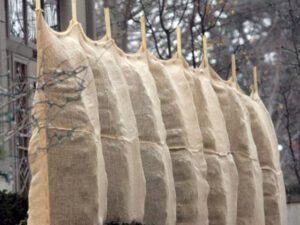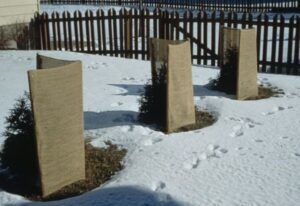 As fall gives way to winter, we’re accustomed to seeing a lot of brown in the landscape – including from the evergreens many of us dutifully wrap in a thick layer of burlap. The intention is twofold: to prevent snow and ice pileup from breaking branches, and to protect the plant from harsh, desiccating winter winds.
As fall gives way to winter, we’re accustomed to seeing a lot of brown in the landscape – including from the evergreens many of us dutifully wrap in a thick layer of burlap. The intention is twofold: to prevent snow and ice pileup from breaking branches, and to protect the plant from harsh, desiccating winter winds.
Is it really worth all the trouble? Let’s investigate first by looking at the problems our evergreens have to contend with over the winter, and then we can address how burlap wrap might mitigate them.
What Causes Winter Damage?
Evergreens have a unique challenge in the winter. Though they don’t actively grow, they still hold some or all of their foliage through the winter. This means they contend with things our deciduous trees don’t have to – namely, moisture loss. Moisture escapes from the needles or scales of evergreens when the sun shines on it or when it is windy. This is an otherwise normal process called transpiration. In the dead of winter, though, our groundwater is of course frozen. The plant’s roots are unable to deliver water up the tree to replace this lost moisture, resulting in brown foliage. This phenomenon is most pronounced in exposed and windy or south-facing planting areas. It can be further exacerbated when we experience a thawing period and the surrounding soil is dry.
What’s a gardener to do? Truth be told, if you plant the right evergreen in the right place, you’ll never have an issue. This is likely why many people swear by their annual burlapping tradition, while others don’t bother and year after year their evergreens emerge unscathed in the spring.
Siting Is Everything
Some evergreens are more susceptible to this damage than others, but it can happen to any evergreen. Cedar, false cypress, hemlock, and broadleaved evergreens (such as boxwood, pieris, or rhododendrons) are most susceptible. These plants in particular should be planted in sheltered locations that do not face south or west. Many of these plants also require moist soil; avoid planting them in dry, rocky or sandy locations.
Of course, this advice doesn’t help us when we already have a pair of 12-foot-tall cedars flanking our south-facing front door. So let’s address our original question: does burlap actually help?
Yes and no.
The Burlap Paradox
Burlap provides our evergreens with a degree of protection by blocking some of the wind and sun that normally causes problems. However, when we wrap our plants directly with burlap it becomes a double-edged sword. In this situation burlap not only serves as a barrier but also a blanket. When we have a sunny day or a midwinter thaw, the burlap creates a heat bubble that can trick our evergreens into thinking it’s warmer than it actually is. This is bad because the exposed edges of the plant begin to break dormancy; when temperatures drop back down all of this plant tissue is injured or killed.
 You can circumvent this problem easily. Rather than wrapping your plants directly, consider erecting a burlap ‘screen’ on the sides of the plant that receive the prevailing wind or sun. This can easily be done with a pair of wooden stakes, burlap, and a staple gun. Situate your barrier at least a foot away from the edge of the plant.
You can circumvent this problem easily. Rather than wrapping your plants directly, consider erecting a burlap ‘screen’ on the sides of the plant that receive the prevailing wind or sun. This can easily be done with a pair of wooden stakes, burlap, and a staple gun. Situate your barrier at least a foot away from the edge of the plant.
The downside of a burlap screen is that it doesn’t protect your evergreens from snow and ice accumulation. Cedars and junipers are most susceptible to this damage, so it might be worth taking additional measures to protect them. Try using nylon stockings to tie the weakest upper branches together to prevent breakage (but make sure you remove them in the spring!). Clear plastic netting can also be used.
Water Well
The best advice we can give when it comes to protecting evergreens in the winter is to water them well throughout late fall. Drought-stressed evergreens are far more susceptible to winter damage than those that have been adequately watered. Mulch also retains moisture, and is a must for any susceptible evergreens planted in exposed sites.
In case you missed it, last week we discussed a number of late-fall tasks that are important for your garden. While you’re outside with the burlap, make sure you’ve checked off some of these other tasks!
